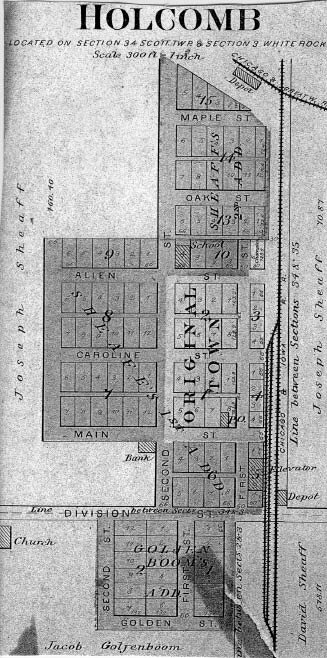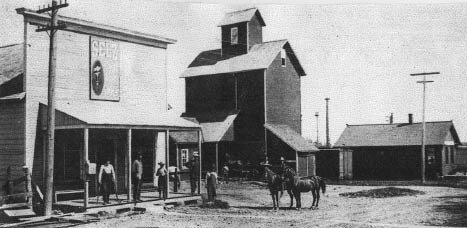
Discover rewarding casino experiences. 
Click on the Flag for More Information |
Hazelhurst, between Polo and Milledgeville at the rail side was one of those multitude of country stations that cropped up along railroad tracks to more handily expedite the marketing of locally produced crops and livestock. In the case of Hazelhurst’s beginnings they were in 1886 when the Burlington aimed westward inspiring others like it to become little “depots” that for awhile were centers of commerce where schools and churches were social hubs and society developed, the most common benefit of all. Hazelhurst being on the boundary line between Ogle and Carroll counties, claims history in both though mostly in Ogle. But the railroad tracks went on down the line to be responsible for a rebirth of Milledgeville, already fifty years old. With the coming of the Burlington depot just to the west edge of “Old Town,” it pulled up its roots and moved baggage and businesses to the new site and enjoyed a fine newness. An early day depot scene is depicted on the side of a commercial business at the south end of Main at Railroad in Milledgeville. At that same time at Hazelhurst a grain elevator and stockyards were built to accommodate the prospective trade. At that period most of the merchandise in stores all over the nation was being carried in and out by train, roads being mostly impassable with dirt and mud hub deep and too heavy for large items. The unloading (or loading) of a train was a local social event! The customer or dealer had ordered by mail and it was delivered by rail, the telephone still a tad unreliable especially long distance ordering over those flimsy wires! The telegraph was a second trusty method. A general store pictured here from the Ogle County history of 1976 was an early enterprise and a gathering place for the neighborhood. It was open seven days a week including Sunday morning. A perquisite grew from that service with a peddler’s wagon going about the countryside every day (by a different route each time). It sold basic household needs, kitchen items, patent medicines, fabrics to stitch up, local news, and whatever had become necessary, or some low cost indulgence. The farm wife who “kept” chickens would trade the hen’s eggs to the paddler and the children would hope that a few penny’s change would summon up a stick a candy or a box of Cracker Jack.
The peddler in the case of Hazelhurst’s store continued on into the motorized age when a truck replaced the horse teams and wagon that passed over quite a distance, perhaps all the way up to Eagle Point, a mile or two away, and having been a bustling trade center at an earlier day ... Several “manufacturers” were located there ... A chair factory that made wooden household items such as spinning wheels, swifts, utensils and so forth; a tanner who put out gloves or leather aprons and sheepskin overcoats, naturally, buying skins from local trappers/hunters. A cooper’s shop made barrels and kegs for everything imaginable in those days but mostly for flour and pork. Flour barrels might go to nearby Wilson’s mill with the barrels for pork and other goods principally selling at river points such as Fulton and Savanna or Galena. Eagle Point’s inception had occurred about 1840 when Mason Crary opened a store there on the busy segment of the Peoria-Galena Trail, a major highway to the river and lead mines. In the 1850s it became the Telegraph Road to indicate its modernity. After forty years had passed the village was in decline, a bit obsolete for the fact that the railroads had shown their muscle and taken over transport of goods of all sorts. Hazelhurst might replace it as a center for commerce. The old Presbyterian Church was moved south from Eagle Point to Hazelhurst to become its town hall. The handwriting was on the wall, so to speak, the renovated church wall!!! Both villages had physicians and post offices; Eagle Point’s origins as Elkhorn Grove in 1837 and Hazelhurst’s in 1888. Nearly fifty years difference was a couple generations of change afoot with the modern day coming in by rail instead of along a dirt trail. Anyone could go or come from Hazelhurst to anywhere else in the nation. The station became a key market for the wide prairie farms spread around it. There is no hint that we found of the origins of the name for Hazelhurst or last week’s Harper. Perhaps they were names of railroad executives or their wives such as Chadwick and Thomson. Watch for Hazelhurst signs north off the Milledgeville-Polo blacktop. H is for HOLCOMB which sets on the line dividing Scott and White Rock Townships in Ogle County, our last of the four H’s ... It sprang up along a railroad, too, it being platted inn 1876 by Joseph Sheaff, a large land owner. It became a trading center for its neighborhood beginning with construction of a grain elevator by Sheaff. A few stores came in and some residences built that year. Grain elevators dominate the skyline yet. Some businesses remain with a couple handfuls of residences to mark its long ago survey. That it remains viable is the fact that very recently their bank had an attempted robbery! There were at the earliest time the usual trades such as blacksmith, harness maker, carriage/wagon builder that today have been replaced by mechanics and car dealers. A physician, churches and school built in the years to come; hardware, lumber yard. The German Methodists built a church for $2,800 in 1878 where German services were held two weekends a month; English, one Sunday. A Masonic Lodge, the Meridian #505, transferred to Holcomb where 47 members met every month on or before the full moon. Joseph Sheaff had come in 1855 but didn’t plat until twenty years later, his residence then being in the center of the village “with broad acres surrounding it and attaining its present growth in just a few years to present a thrifty appearance,” he wrote two years later. It was he who gave the village its name to honor W.H. Holcomb, a deeply devoted investor in railroads of the day. He lived in Rochelle. Holcomb was described as a big man physically and in abilities—manly character, generous, helpful, public spirited, etc. It’s no wonder that the village blacksmith names his newborn son, William Holcomb in honor of the village and for its name. William Holcomb had attained a captaincy during the Civil War though an enlisted man in the calvary. He came to Rochelle in 1871 and went into railroad management to achieve a much lauded career in that career—general superintendent/manager of the Chicago, Burlington, Northern, Union Pacific, manager of the Oregon Railway and Navigation Committee (?) and was head of the transportation division of the Chicago World’s Fair, 1893. He was requested to direct receivership of the Chicago-Iowa Railroad when it went into financial difficulties a few years after origin. As early as 1857 certain residents of Ogle and Carroll counties had organized a railroad company by that name but nothing tangible ever developed. Not until 1869 did legislative action take place when the Chicago-Iowa Co. was formed to run a line from Rochelle to Mt. Carroll. Several years were spent in litigation with the opposition to the railroad putting forth passionate argument. In 1867 when a railroad bridge was to be put over the Rock River at Oregon and Francis Hinckley came to engineer the project. He became interested in development of the C & I from the early plans of the O & C. He talked up the project with the Chicago, Northwestern line which eventually agreed to aid in its construction and become a branch line. Various towns on the line, eight of them, would give financial aid in the amount of about $400,000 with New York “capitalists” adding a million dollars. The work commenced at Aurora in the fall of 1870 and was completed to Rochelle by December 31st. Due to parts of the contract being unfulfilled, the opposition to the line brought litigation. Finally in November, 1871 the tracks were laid to Forreston where it met the Illinois Central from the south to north. F.E. Hinckley while supervising the bridge construction at Oregon was also promoting the Chicago-Iowa which was subsequently bought by the Chicago, Burlington and Quincy. He, with “capitalists” from Rockford, organized the Chicago, Rockford and Northern that was completed in 1875 from Rockford to Flagg Center in Ogle. It was leased to the C & I for thirty years and 25% of its gross earnings would pay its premium. It soon became apparent that it would not be a financial success although it had appeared to be an important station at Holcomb for instance. The lad all around that location was fertile prairie but had lain fallow much longer than other settlement because there was no timber. And most thought nothing would grow without timber! There was nary a fence from Rockford to Rochelle when Seth Jackson arrived 1854. He plowed a track in the prairie that became the road that today paralleled Route 51 at a later date. Pioneer situations were not yet two generations past and here they were talking of railroads as blithely as if they were ordering a bespoke suit of clothes or new fellows for their buggy wheels. By 1877 the Chicago, Rockford and Northern was put into receivership with W.H. Holcomb as manager, too, until 1881. That year the Chicago, Milwaukee, St. Paul flexed its metal muscles in a take-over scheme but was only able to gull that part of the line north of Davis Junction, the next station above Holcomb. There was passionate opposition from employees of the rail company. A genuine “railroad war” occurred with hired thugs coming out from the city to intimidate the holders. But that’s another story. Court litigation ensued and in spring 1881 judgment returned the C & I to its former directorship. Eventually it was leased to the Burlington company and the two rivals shared a depot at Davis Junction by 1882. Go figure. Meanwhile, Holcomb Station quietly progressed. A post office had been established in 1875, the town platted in 1876 with subsequent growth as before mentioned. Many of the remaining residences today display quaint design and charming vignettes on seeking them out. Holcomb can be found by watching for signs off both Rts. 64 & 72. Descendants of pioneer families still populate the area, an area not settled until a decade and more after much of the surrounding region. It was worth the wait. William Holcomb, who had done so much to promote railroading—honestly—moved to Hinsdale on his retirement though he had deep interests in Illinois coal mining and in western timberlands for the making of railroad ties and utility poles, a burgeoning industry. He died at Hinsdale in March, 1908 at seventy years. He was survived by three children. A hundred years ago he was a well-known man in important services and circles. Today he is practically unrecognized. Only the community of Holcomb carries him into the future.
|





